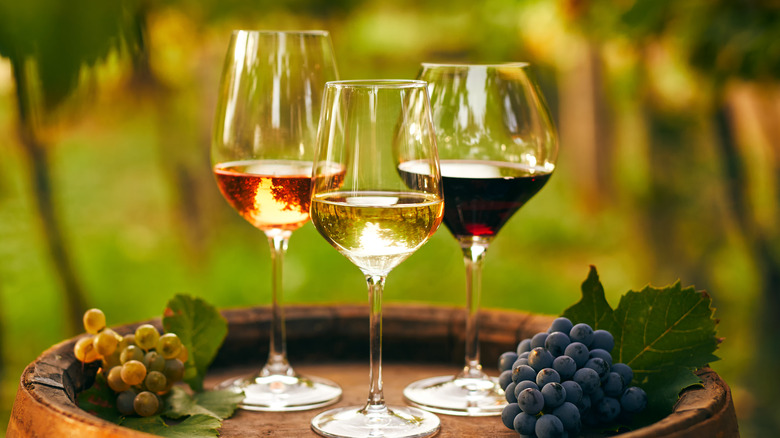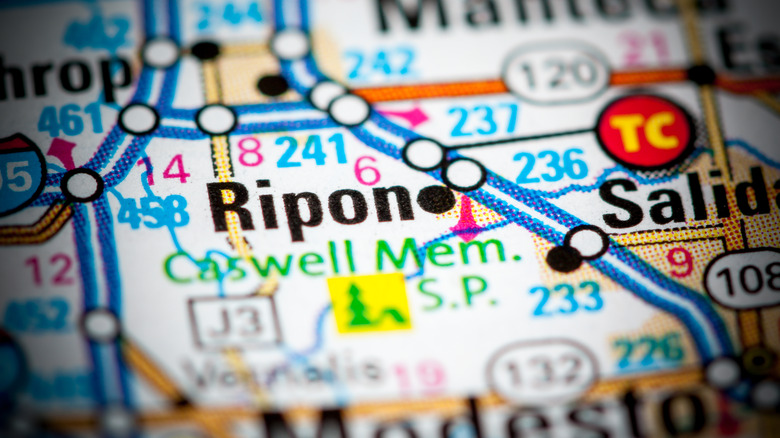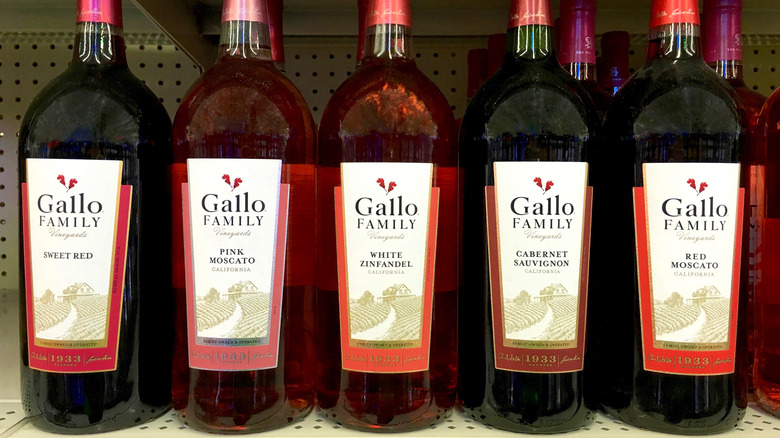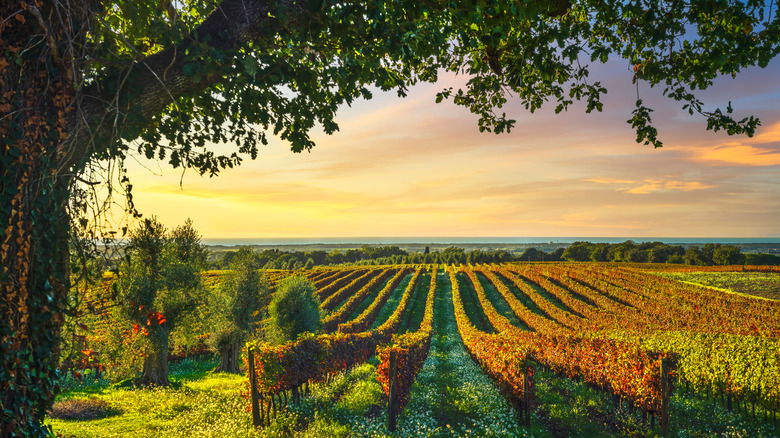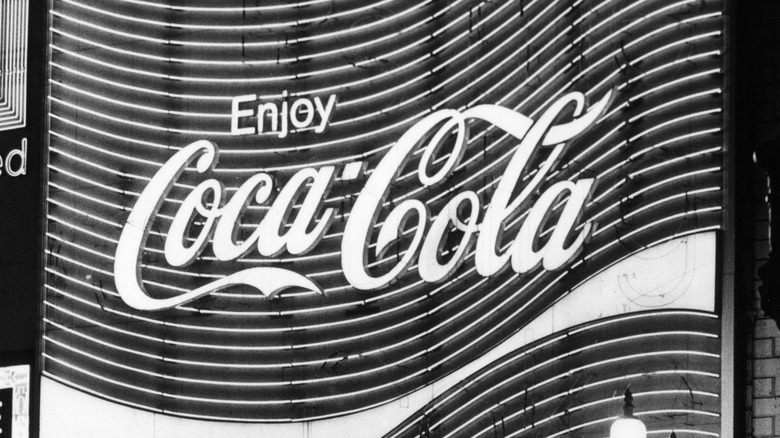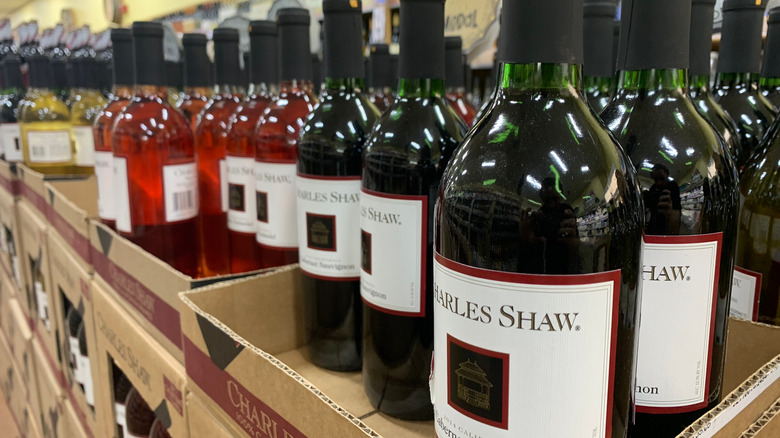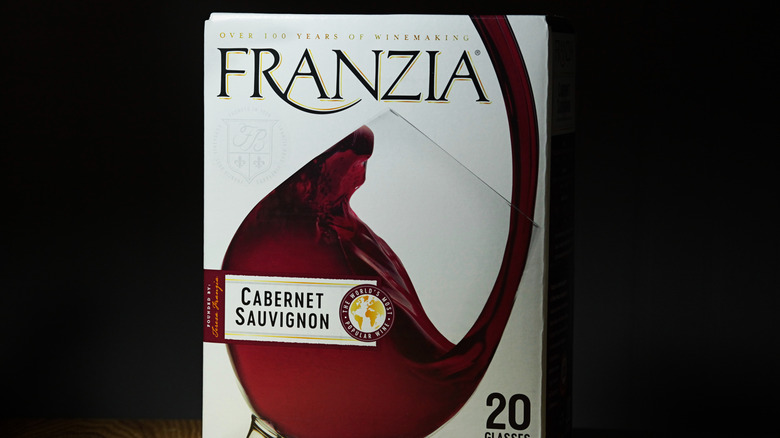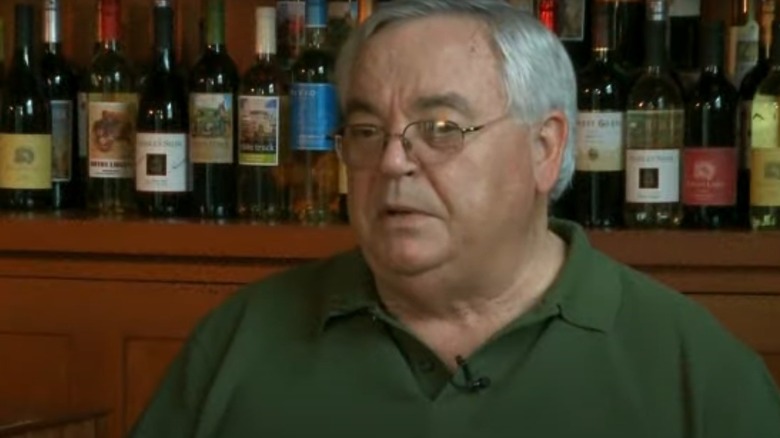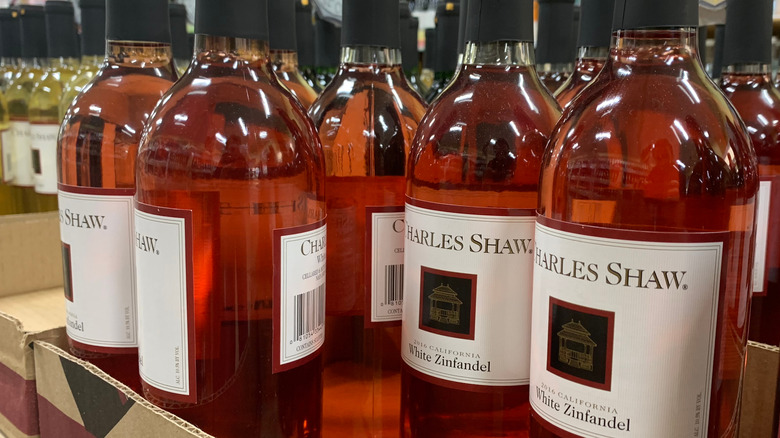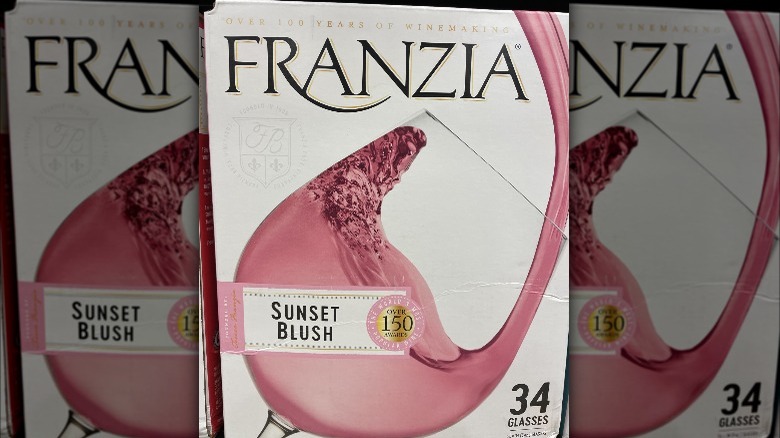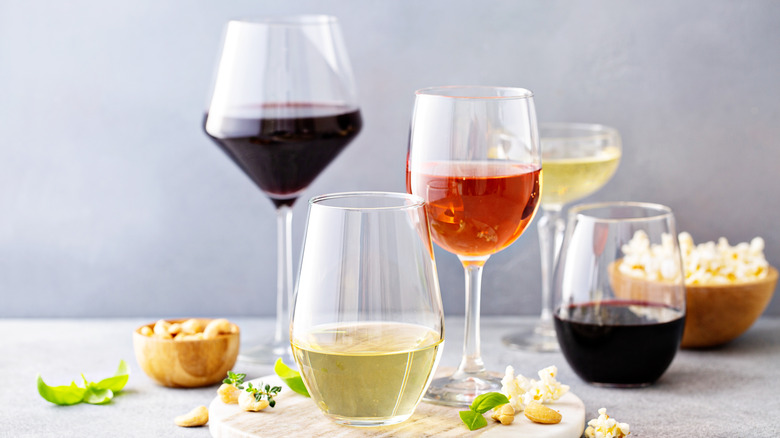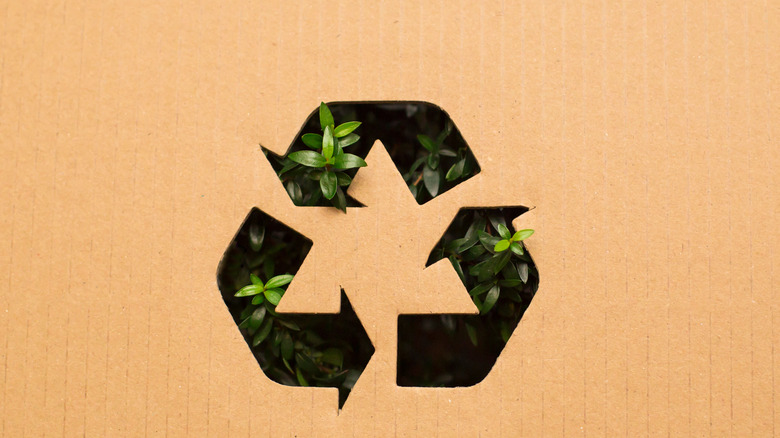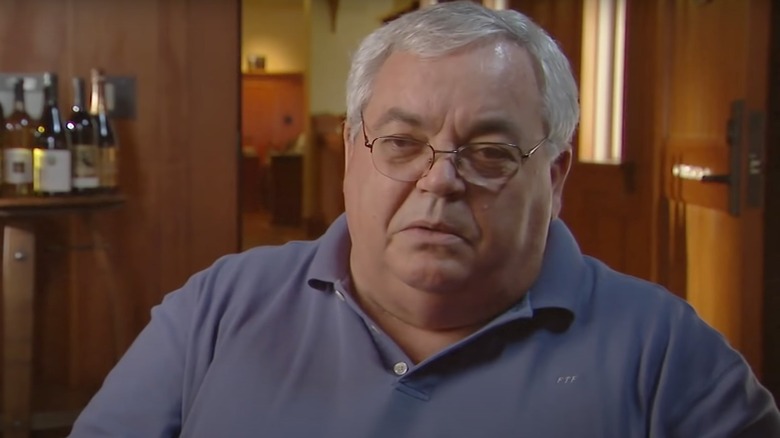The Complete History Of Franzia Wines
For nearly a century, the Franzia family has been delivering affordable, quality wine at a fraction of their competitors price, all while battling buy-outs, growing their clan, and overcoming family obstacles.
The Franzia brand was founded in the 1930s by Teresa Carrara Franzia, an Italian immigrant and bride of Giuseppe Franzia. The couple settled in a small agricultural town in California's Central Valley, where they grew grapes to sell to other Italian families across the U.S. During Prohibition, the Franzia family would host other prominent pioneers in the wine industry like the Gallos, Mondavis, and Rossis, according to the Los Angeles Times. They would wine and dine over homemade wine and authentic Italian food made by Teresa.
As the family expanded, so did their label. The company's other contributions to the world-wide wine industry include creating environmentally sustainable packaging, bringing boxed wine to the forefront of industry sales, launching the popular and affordable Charles Shaw (also known as Two-Buck Chuck) label, and bringing quality wine at a reasonable price to countless tables around the world.
Like many pioneer families that put California on the winemaking map, the Franzias continue to expand their legacy, reputation, and portfolio in spite of criticism and doubt among their competitors.
Franzia Wines was founded by Teresa Franzia in the 1930s
Like many Italian immigrants who made the transatlantic voyage to the U.S. in search of the American dream, Teresa Carrara arrived by boat in 1900 after accepting a marriage proposal from Giuseppe Franzia (via Vice). The couple wed shortly after her arrival, and they settled in California's Central Valley, where Teresa planted her first grape vines in 1906 in the small town of Ripon, according to Franzia.com.
Over the next few years, the newlyweds grew the vineyard to 80 acres while also growing their family brood to include five sons and two daughters. The Franzia family sold grapes to other Italian families during this time and throughout Prohibition, but it wasn't until the end of Prohibition that the Franzia wine dynasty was born.
In the early 1930s, while Giuseppe was visiting family in Italy, Teresa took out a loan for $10,000. She divided the money in half, giving $5,000 to her son-in-law for his own winery that he co-founded with his brother in 1933, and using the other $5,000 to launch the Franzia label, as reported in Forbes.
Franzia was the first winery in Ripon, California
Once Prohibition was over, the doors to Franzia Winery opened in Ripon, California — a small agricultural town in the San Joaquin Valley, according to the book published by the Santa Clara University, "Thinking Outside the Box." With little to no competition in California's Central Valley, Franzia became the first — and now oldest — winery to exist in Ripon.
Located off Highway 120, the winery is now owned and operated by The Wine Group, an employee-owned company that continues to produce wines under the Franzia label, as reported by the Manteca Bulletin. Although the once family-owned Franzia Winery is no longer in the Franzia name, a daughter of one of the Franzias is married to the president of The Wine Group, so, in some way, it's still considered in the family on some level, even if not directly owned by a Franzia.
The small community of Ripon is also home to a handful of other wineries, including McManis Family Vineyards, which opened in 1938 and remains under the McManis name to this day. There's also a relatively newer operation, Lucca Winery, which was established in 2011.
The Gallo and Franzia families go way back
Without the Franzia family, it's possible there would be no E. & J. Gallo wines. The two immigrant families bonded over a shared love of wine, especially during Prohibition, when the Franzias would host the Gallos and other Italian wine industry pioneers like the Rossi family. Although the Gallos and Franzias sold grapes to other Italian immigrant families in the Midwest and on the East Coast, they were limited by the laws set during Prohibition from bottling and selling wine.
In 1931, the two families united through the marriage of Amelia Franzia and Ernest Gallo, as reported by the Los Angeles Times. With the repeal of Prohibition on the horizon, Amelia's mother, Teresa Franzia, saw an opportunity to create a family business by producing and bottling their own wine, thereby creating a year-round source of income. The matriarch took out a loan to not only launch the Franzia Winery, but to also finance her son-in-law, Ernest, with the launch of his winery in nearby Modesto.
According to Forbes, E. & J. Gallo is now considered the largest winery in the world, all thanks to Teresa's entrepreneurial vision.
Teresa Franzia passed the winery on to her five sons
While the matriarch and founder Teresa Franzia was active in harvesting the grapes and helping her sons run the growing business, she and her husband, Giuseppe, took a back seat when it came to Franzia Brothers Winery. In addition, although Teresa had financed the launch of the winery, she held no shares in the company; she and Giuseppe did, however, own the vineyards that supplied their sons grapes (via the Manteca Bulletin).
Franzia Brothers Winery remained a family operation until Teresa's passing in 1949, when she passed on the winery and her entrepreneurial legacy to her five sons (via Forbes). Before she passed, and well into her old age, Teresa was regarded for her work ethic, which she also passed onto her children and grandchildren, who all went on to become pioneers in the wine industry. An article in The New Yorker commended Teresa for her diligence and commitment to the winery.
Franzia sold to Coca-Cola in 1973
Although the Franzia Brothers Winery was a success in the wake of Prohibition and amid the Great Depression, the company voted to sell to Coca-Cola Bottling Company of New York (or Coke-NY) in 1973, as reported in an archived article from The New York Times. The company was valued at approximately $49 million at the time of the sale.
Like many other wine dynasty families, such as the Mondavis, who experienced their fair share of family turmoil, the decision to sell to Coke-NY created a messy rift between the Franzia family, namely Joseph Franzia and his son, Fred. The two remained estranged for several years after that sale even though Fred had moved on to found his own successful wine-making company with his brother and cousin, as well as become the man behind Charles Shaw wines, more aptly referred to as Two-Buck Chuck.
In spite of turning a profit on the Franzia takeover, Coke-NY was experiencing internal management pressure and ongoing turmoil, causing them to sell the Franzia label to The Wine Group in 1981, less than one decade after the monumental purchase.
The Franzia family founded Bronco Wine Company in the aftermath of a family feud
Following the sale of Franzia to Coca-Cola in 1973 and the feud between Joseph Franzia and his son, Fred, that ensued (via The New Yorker), Fred split off from his parents to co-found his own company, Bronco Wine, with his brother Joseph and cousin John, according to Winemag.com.
Aside from launching the Charles Shaw label, often referred to as Two-Buck Chuck, Bronco Wine Company portfolio includes a slew of other affordable, high-quality wines like Rare Earth, Pacific Pinot, Grove Ridge, and Fox Brook, to name a few. The company also boasts organic farming methods, bulk production, and international distribution.
Bronco Wine Company remains family-owned to this day, with a company goal of becoming the largest privately run vineyard in the U.S. The company now distributes globally, bringing low-cost, high-value wines to tables around the world.
Coining the term boxed wine happened by accident
At the core of their winemaking values, the Franzia family wanted to create a product that was both affordable and delicious, but the idea to box it didn't come into play until The Wine Group purchased the label in 1981. Nowadays, the Franzia boxed wine label is likely as recognizable in grocery and liquor store aisles as the Nike swoosh is in a shoe department, largely due to its iconic boxed packaging.
That said, the term boxed wine was not what The Wine Group intended when they introduced the wine-tap technique. However, with other competing wine-tap options on the market, brand confusion unfolded, threatening to decrease the value of Franzia. In an effort to belittle Franzia, competitors began referring to the wine tap as "boxed wine," and to the dismay of The Wine Group, the catchy nickname stuck.
That said, The New York Times reported in 2003 that boxed wine, or bag-in-the-box wines, are increasing in popularity and demand worldwide thanks to the triple-layer airtight bag technology that actually helps to preserve the quality and integrity of the wine, even more so than an open bottle.
Fred Franzia was known was the winemaking anti-snob
Fred Franzia, a third generation son of the Franzia wine dynasty, was always known for being a winemaking anti-snob. Perhaps this was a nod to his grandmother, who built a legacy on making and selling wine at a value, or perhaps it was because he understood that a growing number of Americans wanted good wine at a great price. Either way, Fred Franzia made it his mission to offer wine at an unbeatable price (via Forbes).
In a statement delivered by Bronco Wines shortly after his death in September 2022 and published in The New York Times, it was said that "core to his belief was a vision that wine should be enjoyed and consumed by every American table." When he launched Bronco Wine Company with his brother and cousin in the early '70s, the family team made it their mission to continue offering affordable table wines available to consumers across the U.S.
The Franzia family is responsible for Two-Buck Chuck
Born out of a vision to create quality wines at a fraction of his competitors' prices, Fred Franzia brought Charles Shaw wine (more aptly known to consumers as Two-Buck Chuck) to Trader Joe's in 2002, with a starting price point of $1.99. Nowadays, Two-Buck Chuck is available for $2 to $4, but it's still one of the cheapest wines on the market. And it doesn't taste half bad to boot (via Quartz).
With his business Bronco Wine Company ranked as the 13th largest winemaker in the U.S., Fred was known for his unorthodox and unpretentious approach to crafting and selling affordable wine like Two-Buck Chuck. In order to keep the price point low, Fred had to get creative by bottling it in lightweight glass, which meant he could ship more bottles at a time. He also used natural cork rather than twist off to make it seem more high end than its low-cost competitors. He also kept his headquarters in California's Central Valley rather than setting up shop in the more expensive vineyards and estates surrounding Napa County. He also buys grapes and blends in bulk, lowering the cost of production from farm to harvest.
Franzia boxed wine is the largest-volume wine brand in the world
Although some winemaking Australians claim to be the inventors of the world's first boxed wine some 50 years ago, bag-in-a-box wines are now made in even the most pretentious wine regions around the world, including California and France, as reported in The New York Times. Among other titans in the boxed wine industry like Gallo, Black Box, and Peter Vella, Franzia boxed wine is the largest-volume wine brand in the world, according to Forbes.
Although boutique retailers and highbrow winemakers remain skeptical of boxed wine's appeal, Collin Cooney, marketing director at The Wine Group, which now represents Franzia, says that boxed wine consumers are "more loyal" than those who buy by the bottle (via Shanken News Daily). Consumers are starting to appreciate the wine tap technology that helps maintain the quality of the wine in a bag at a bargain price, and Franzia still remains at the forefront of the boxed wine market.
There are 20 varieties under the Franzia label
Known for its affordability, convenience, and volume, Franzia boxed wine has come a long way since its inception in the '70s. There are now over 20 varieties under the Franzia label, including red, white, and blush wines (via wine.lovetoknow.com). Under the reds category, there are two cabernet sauvignons, one of which claims to be "bold and jammy," as well as classic options like burgundy, chianti, pinot noir, and merlot. There's also a chillable red wine option, a dark red blend, and a fruity red sangria, all perfectly packaged in an affordable box, via Franzia.com.
In the white wine category, Franzia offers the usual suspects like chardonnay, sauvignon blanc, and pinot grigio. There's an additional chardonnay option that claims to be the "richest most buttery chardonnay" Franzia has ever offered by the box. For the customer who isn't sure which white is right for them, there are always the blended box options, like crisp white and refreshing white. And lastly, for the wine drinker with a sweet tooth, Franzia offers a Moscato with hints of peach and apricot.
Lastly, the blush category includes pink-colored varieties like white zinfandel, rosé, pink moscato, and a semi-sweet sunset blush. Each blush box boasts notes of berries, with a touch of dryness and a sweet finish.
Franzia packaging is environmentally friendly
There's not only greenery in the vineyards of The Wine Group, which represents Franzia, but the company also boasts environmentally friendly practices from production to packaging, according to Franzia.com. For starters, their bag-in-a-box wine lasts much longer (up to six weeks once opened) than their bottled competitors' product, and a longer shelf life means less waste for consumers.
In addition, once you've drunk every drop of your boxed wine, the box is recyclable, and the environmentally friendly packaging saves on glass and corks. The company also boasts a BPA-free plastic bag, meaning they don't use harmful industrial chemicals in the packaging of their wine.
Lastly, buying a box of Franzia means lowering your carbon footprint as the company is able to pack their trucks with double the amount of product than if their wine was bottled, meaning it's half the amount of greenhouse gas emissions when it comes to transportation.
Wine icon Fred Franzia died in 2022, leaving behind a legacy
Fred Franzia died at the age of 79 in September 2022, but no cause of death was reported by the family or by his company, Bronco Wine, according to The New York Times. A third generation winemaker in the Franzia dynasty, Fred Franzia was best known for his overall legacy of creating affordable and quality wines to tables across the world.
While there were many skeptics within the industry who criticized Fred for his unconventional and anti-snob approach to making and selling wine, no one can deny his powerful impact in the industry. Not only is Franzia boxed wine popular around the world, but Two-Buck Chuck also brought affordable wine to American families across the country, as reported in The New York Times.
His impact wasn't always a positive one, especially in 1993 when Fred stepped down from being president of Bronco wines after being busted for misrepresenting his product. It turns out he had been using cheap grapes that weren't in fact zinfandel or cabernet sauvignon as he had labeled them on the bottle. He wasn't punished for long by his company, and he returned as chief financial officer temporarily, after which he became the chief executive.
